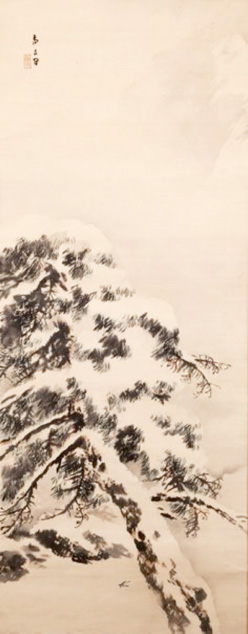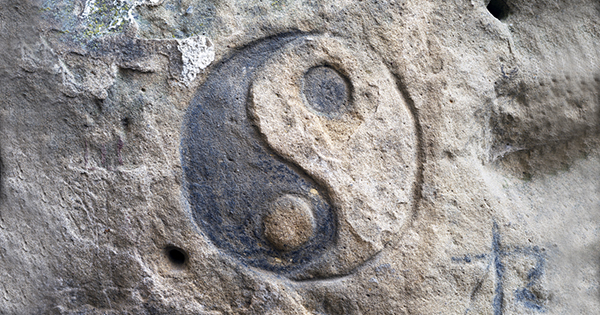The balance of fangsong with peng is sometimes illustrated with the analogy of a pine tree which can withstand heavy snows and, when the weight of the snow bends the boughs far enough to slough off the snow, the limbs spring back to their original positions. The bending bough is fangsong while the limb springing back into place is due to peng.
 This is in contrast to hardwood trees with their stiffer structures that are susceptible to breaking under strong winds or heavy snow or ice, especially while the trees retain their leaves and present larger surface areas. Hardwood trees could correlate with “external” or “hard” (剛 gang, hard/firm/strong) styles of martial arts, whereas softwoods could correlate with “internal” or “soft” (柔 rou, soft/supple/flexible) arts like Taijiquan; hardwoods are stronger whereas softwoods are more resilient.
This is in contrast to hardwood trees with their stiffer structures that are susceptible to breaking under strong winds or heavy snow or ice, especially while the trees retain their leaves and present larger surface areas. Hardwood trees could correlate with “external” or “hard” (剛 gang, hard/firm/strong) styles of martial arts, whereas softwoods could correlate with “internal” or “soft” (柔 rou, soft/supple/flexible) arts like Taijiquan; hardwoods are stronger whereas softwoods are more resilient.
While these analogies are imperfect (hardwoods can resist many forces, especially in the winter when their leaves have been shed, and some pine limbs break under heavy snow, ice and strong winds), the pine tree limb sloughing off the snow and springing back into place does illustrate the quality that we are looking for.
We want to have a resilient structure that freely bends without collapsing or breaking. We want to have the quality of a properly inflated rubber ball that can absorb forces without loosing its integrity; the rubber being strong but not stiff. We want the looseness (fangsong) to be able to turn without hindrance, simultaneously with a structure (peng) that allows us to “root” forces from our opponents if desired (i.e., transmit pressure through our structure and to our feet and into the ground).
We want to have “rooting” without requiring additional effort. We want to receive (or issue) pressure evenly through our body without having the forces get “stuck” in, or “leaking” out of, any individual joint. We want to be able to receive (or issue) force without losing our freedom of movement so that we maintain our ability to rotate. We want to be able to extend while maintaining looseness (extended but not straight).
Another analogy that illustrates the balance between fangsong and peng is that of a properly inflated tire. A vehicle with properly inflated tires will have a smoother ride than if the tires are either overinflated (stiff; too yang) or underinflated (collapsed; too yin).
The quality of a drawn bow is also used as an analogy in Taijiquan. A good bow material needs to be able to expand and then return on the outward facing side, whereas the material on the inner side needs to compress and then return when the bowstring is released.
The stretching/expansion of the outer bow surface is like fangsong, while the compressed inner surface produces peng. Both contribute to the power transmitted to the arrow when the bowstring is released. This is not very different than what is happening with the snow burdened pine tree limb discussed earlier.
But how can we determine if we have the proper balance between fangsong and peng? Visually this can be difficult, especially in solo forms, but many of the postural principles of Taijiquan can point to problem areas.
One example is that when our shoulders are too tense they tend to rise, and when interacting in push-hands or other interactive practices, they tend to become stiff and have restricted movement. If they are too loose, they fail to provide structure to the arms when under pressure from an opponent; if too loose, the shoulders tend to collapse towards the back and they get moved behind the body.
If movement is not smooth and free, then fangsong is insufficient. If ones structure collapses under pressure, then peng is insufficient.
Often the expansion of the joints (including the lengthening of the spine), which is due to peng, produces greater freedom of movement for those joints (i.e., fangsong). Loose joints (fangsong) depend on them not being constricted; the space required for the freedom of movement of the joints is provided by peng expanding the spaces between bones. Relaxed and open is called songkai (松开)
Taijiquan emphasizes expanded, resilient, springy and mobile joints rather than compressed, tense, stiff and solid but immobile joints. Fangsong plus peng produces these desirable qualities for the joints.
The principle of suspending the crown of the head depends on peng, and lengthens the spine. This fullness is different than pushing up the head forcefully; it is more like the energy of a seedling rising through compacted dirt, even though the seedling itself is weak and flexible, it’s upward energy is powerful.
The analogy of a shirt hanging on a coat hanger also illustrates both peng and fangsong. The hanger is peng and corresponds to suspending the crown of the head, while the shirt illustrates fangsong and represents the shoulders sinking down. Peng is necessary for fangsong in this analogy; the shirt does not drape down without the hanger supporting it.
Another example of fangsong balancing with peng is lifting the back and concaving the chest. The lifting back is due to peng (and is yang, expanding/lifting), while the concaving chest is fangsong (and is yin, absorbing/sinking). Both of these actions/energies support the other; they are complementary, not contradictory.
Another example is issuing energy/force from the spine (or mingmen, 命門 life gate), which corresponds to peng (and is yang), while sinking qi (氣 vital energy) to the dantien (丹田 elixir field) which corresponds to fangsong (and is yin).
The contributions of both fangsong and peng can also be illustrated with a coiled spring. A coil of rope (too yin/limp) or a coil of stone (too yang/stiff) do not work as springs. What is needed is the ability to both compress and expand provided by the coiled metal. The metal coils, and the spaces between them, are needed for the spring to work.
A spring also needs a solid support to compress into and to expand away from. In Taijiquan this is provided by our ability to “root.” When referring to the entire body, this “rooting” is in the feet (when standing). But it can also refer to individual segments of the body – the five “bows.”
The five “bows” are the two arms and two legs plus the torso. The “roots” of the arms are the shoulders, and the “roots” of the legs are the hips. The “root” of the torso is the pelvis. For these five bows to work well, all need the ability to compress (fangsong) and expand (peng).
The goal in Taijiquan is to be comfortable (舒服 shufu) and to maintain joint mobility even when interacting under pressure from partners or opponents. To do this requires many things, including balancing fangsong with peng. Being aware of both fangsong and peng is being aware of both yin and yang, which together is Taiji. Focusing on just relaxation (fangsong) without structure (peng) is only practicing half of what is necessary. Focusing on yin without yang is only half of the complementary pair that form the Taiji diagram, which is the foundation of the principles that Taijiquan follows.

Leave a Reply